Exaltation of the Cross of the Lord Description Icons. The meaning of this church holiday. Prayer before Icon
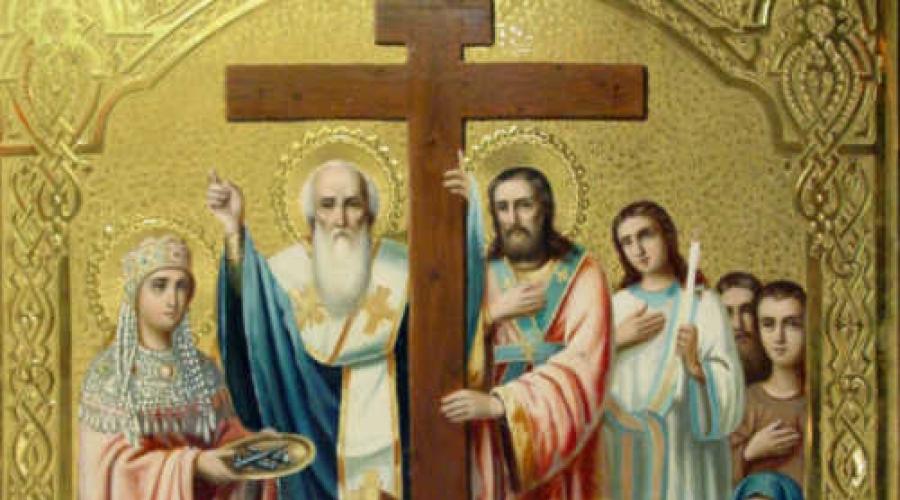
September 27 Orthodox Church celebrates the holiday of the Exaltation of Honest Life-giving cross Lord.
In Russia, the extension is also called in alignment or shifting - words that denoted the movement, change of state. During this holiday, it is customary to keep the post: "Who will fasten on the upstream, then seven sins will say." Previously, this day most often fir cabbage and dishes from it. "On the upstream of the kale in the porch" or "Shoot, Baba, about the cabbage - the upstream has come," the people spoke.
Acquisition of a honest life-giving cross of the Lord
Emperor Konstantin Great, remembering about God's signwhich has become a promise to win the victory over the enemies (the phenomenon in the sky of the cross with the inscription "Sim Win"), decided to find a cross on which Christ was crucified.
In search of shrines, he sent his mother to Jerusalem, Tsaritsu Elena. She managed to find out that the cross was buried by the beauty of Venus. The pagan temple was destroyed, they began to dig the land on this site, and soon they discovered the Merrator's coffin, three crosses, four nails, with which Christ was naked to the cross, and a table with the inscription "Jesus Nazhai, Tsar Jewish", made on the order of Pilate. The true cross of the Lord managed to determine due to the fact that the shrines immediately began to occur. Not far from the place where excavations were held, a funeral procession was held, and when the Cross of the Lord was laid on the dead man, he came to life.
Patriarch Macarius and other spiritual entities began to raise high, erect the Holy Cross, so that those who came to worship Christians could at least emit it to contemplate.
In Constantinople, St. Elena brought a part of Life-giving tree and nails. Equal to the Emperor Konstantin commanded to erect the majestic temple in Jerusalem in honor of the resurrection of Christ. He was consecrated on September 26 (according to a new style) 335 years. The next day, September 27, established the holiday of the Exaltation of the Honest and Living Cross.
Stalloat Cathedral
"The holy crosses of the holy crosses are placed on the holy churches, the holy crosses are indignantly and delivered, and before the day there is a lot of trouble," the rule of the outline cathedral, which took place in 1551. Thanks to this position, the string, most of the ancient sandwich crosses in Russia remained up to the XX century. In general, there was a custom in Russia: to celebrate the exaltation of crosses on the domes of the temples under construction.
Inscriptions on Orthodox Crosses
Inscriptions on orthodox crosses must be necessarily. "Save and save" - \u200b\u200bthe most prominent inscription, which appeared on personal crosses only XIX century, it means a continuous prayer that makes orthodox man. Until the XIX century, they were quite common, "praise the cross" ("Cross worship, Vladyko ..."), Psalm "Live in the help of Vynyago ..." and the trophari life-giving cross of the Lord.
In addition, "Jesus Christ, King Jewish" wrote on the cross. In the center of the four-pointed cross, the eight-spin and wrote "GG" ("Golgoga Mountain"), "GA" ("Head of Adam"), Nika ("Christ Winner"), "NLRB" ("Loboral Paradise").
Tradition of decoration of crosses
Tradition to decorate Crosses Enamel, turning them into the real works of jewelry art, goes back to legend about the "thrust of the Tree of the Cross".
Many of existing icons Deals important events In the life of Christians. Icon "Exaltation of the Cross of the Lord" describes the acquisition of the Tsaritsa Elena of the Holy Cross, at which Jesus Christ was crucified. There is a holiday that is dedicated to this event.
What does the Holiday of the Cross of the Lord mean?
The holiday is customary to celebrate on September 27, and he is dedicated to the return of the Cross of Christ Believers. He is considered to be a two-month in the afternoon dedicated to Jesus, therefore, and called the Lord's day. In 326, there was an acquisition of a cross near the Golgotha \u200b\u200bMountain. In the VII century also there was a return of the cross from the captivity of Persians. In honor of the return of the Cross, the emperor gave an order to build in this place. On this day it is recommended to stick strict fastThanks to which it will be happy happily successfully. It is forbidden to start something new on this day and build some plans, because they will not be successful. House cleaning on this day helps to drive out unclean power. There are signs that if a person sees birds on this day and makes a desire, then you can count on its implementation.
What does the icon "Exalten the Cross of the Lord look like?
In the center of the composition there is a cross, which stands on a stepped elevation and supports several priests. Around the distress are believers who are rejoicing the return of the shrine. In the background depicted a temple. On the different images Some of the specified details may be absent, but only the cross remains unchanged.
What helps the icon "Exalteniation of the Lord Cross"?
This image has huge powerwhy he creates miracles. It is necessary to pray before the icon necessary to women who suffer from infertility, as well as people with serious diseases. Helps icon believers to find peace and, in the period of confusion and doubt.
There is a special prayer "Exalteniation of the Cross of the Lord":
"Save, Lord, your people and bless your heritage, victory orthodox Christian On the resistance granting and keeping your cross in your cross. "
Icon "The erection of the Cross of the Lord "is associated with the acquisition of the relic and one of the main Orthodox holidays. The events depicted on the icon describe the eternal struggle of good and evil, where the winner is always alone - the Lord.
The icon "Exaltation of the Lord Cross" personifies the event that occurred in the IV century of our era. It is associated with the acquisition of the shrine on which the Savior was crucified. Sacred apocryphal tell about how the inners threw all the strength to finally erase from the face of the Earth any evidence of the life of Jesus Christ. Under the temple erected by pagans on the mountain of Calvary in honor of his deity, the cross was hidden, on which the Savior was once crucified. Christians did not lose the hope of finding the shrine, and after three hundred years, the life-giving cross was found. And the wonders that occurred on this day were captured on the icon as evidence of the victory of the Lord over false and deception of dishonest people.
History icons
After Jesus Christ gave his life to his sins of all the people of the earth, the Holy Cross was lost. He was hidden by inners, and the Christians could not find him for a long time. They did not lose hope, and a miracle happened in the IV century. Not far from the city of Golgotha \u200b\u200bin Jerusalem Tsarina Elena found a cross on which the Savior crucified. For many years she was looking for him, but, according to rumors, one Jew knew where the life-giving cross was hidden by enemies. Elena found him in a cave littered with garbage, stones and earth. To learn about his authenticity, the fatal woman was invited to the destroyed temple. As soon as she touched the cross, the flour left her body, she healed, which was proved not only the genuineness of the relic, but also divine help and love for each living on Earth. This day is one of the most important Christians in the life.
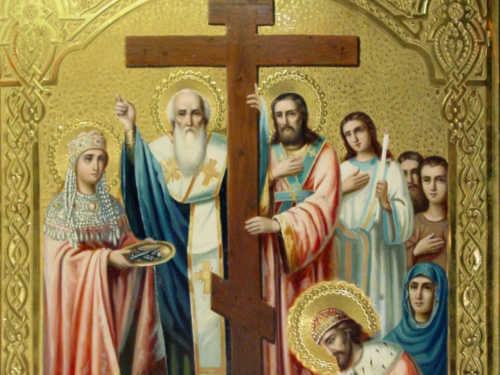
Bishop of the local church three times raised the cross in the name of his acquisition. Hence the name "Exaltation". This holiday is considered one of the twelve major Orthodox holidays. And the icons reflecting this event serve as a reminder of the divine patronage.
Where is the holy image
The shrine "Exaltation of the Cross of the Lord" is kept in many churches of our country. In the Moscow Temple of the Evidence of the Cross of the Lord on a pure enemy there is an icon with the most common plot. More early lists You can meet in the Vatican and the Roman monastery, in Chapel of San Sylvester.
Description Icons "Exaltation of the Cross of the Lord"
Each icon painter saw important details of the events in its own way, so the shrines differ in the plot and execution. Mostly on the icon depicts a crowd of the people, and behind them - the church. In the middle of the icon depicts a saint, climbing the cross over his head. Ahead of shrines - people who came to see with their own eyes the miracle, and on the right - the rulers of Konstantin and Elena, who helped believers again to gain the cross of the Lord.
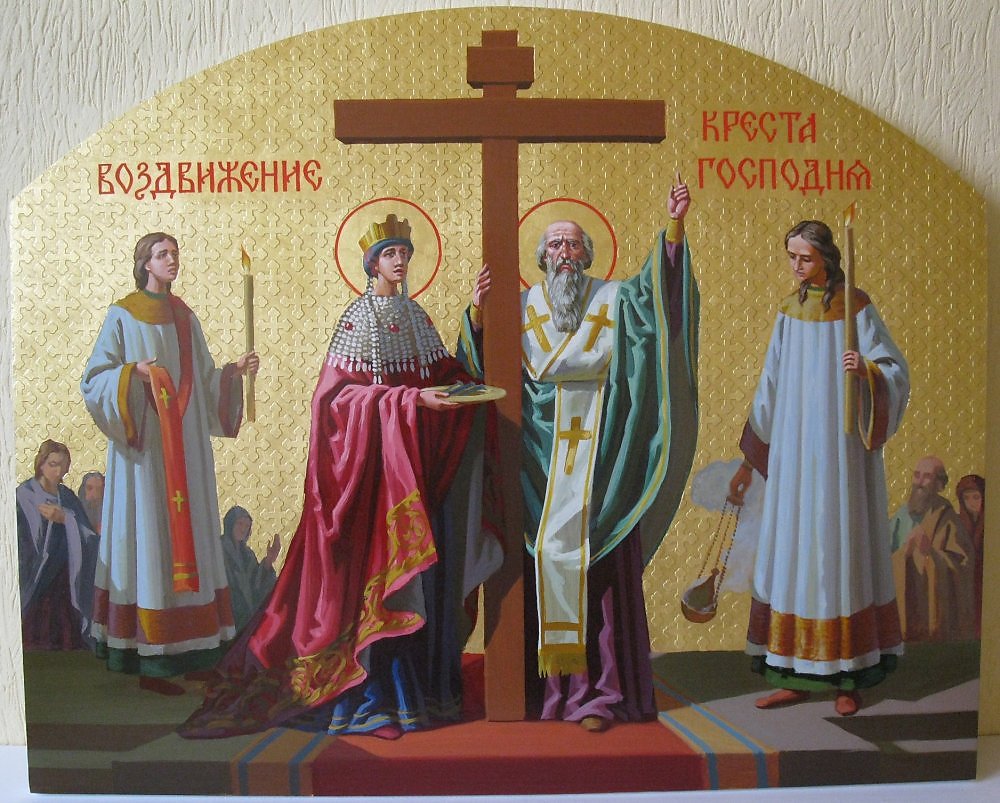
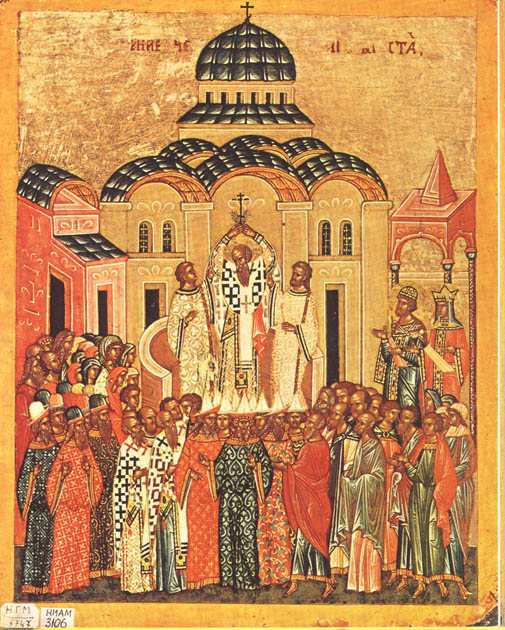
What helps icon
Before the icon, they are praying for healing from serious ailments, including incurable. The shrine provides support for women in the fight against infertility. People in the plea are asked near the icon about cure from pain in the teeth, bones, joints, from chronic diseases. The power of this shrine protects faith, does not allow her weakening and directs the path of true happiness and grace.
Days of celebration
On September 27, there is a holiday of the Exaltation of the Holy Cross. This is a celebration for everyone. orthodox people It is considered an important day. The people recall the great sacrifice of the Savior and the bottom of the acquisition of the cross.
Prayer before Icon
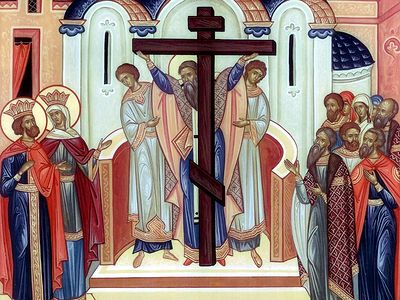
"Oh, Cross Holy! You are the keeper of my body and my soul! You're my intercession and defender! Saints, let me go through my way to the end! Give me healing and remove me from diseases and ailments! Protect evil spirits from enemies and spirits! Let us ask the cross, so that everyone felt his strength! Strengthen the will of my and my heart, give the blessing and silence the Lord, in order to forgive me my sins! Yes, I am sending the greatness of the cross of the life-giving, because the degraded Savior has undergone the sinners for the souls! In the name of the Father, and the Son, and the Holy Spirit. Forever and ever. Amen".
Icon "Exaltation of the Cross of the Lord" helps us fully imbued with the events of the day, to understand the significance of the Great Relic. After all, the enemies of Christ did everything possible to desecrate his memory and settle in the hearts of believers deception and the idea that the Savior was not. But for three hundred years, faith in the Lord was unshakable, and God pointed the way. Do not forget to meet orthodox holidayBy observing all the church traditions of this day, and then Most High illuminates and your way with the light of hope and happiness. We wish you the world in the soul. be happy And do not forget to click on the buttons and
Exaltation of the Cross of the Lord - Icon, which has several images. This is due to the fact that each icon painter described the finding of the Cross of Jesus in different ways, trying to specify the main details. For Christians of that time, this is a huge event, so several temples, churches were built in his honor, composed of prayers, a song, a tropar, the sacred texts, the date of the same name is established.
Exaltation of the Cross of the Lord: History
Historical facts say that the return of a life-giving Tree happened thanks to the Emperor Konstantin Great and his mother Elena. Konstantin was by the genus Roman, according to faith, like his father, a pagan, and his mother was a Christian. After the death of Father, Empress Elena actively engaged in the spread of Christianity. The son came to this faith not immediately. This was facilitated by the sign before one important battle. Long doubts, torture, appeals, plenty to God contributed to the sign - the appearance of a cross in the evening sky. It saw the emperor with his army. At night, he also dreamed of Jesus, who informed him about the coming victory over the enemy, if on clothes, weapons, the banners of the warriors will be depicted his symbol.
Konstantin, fulfilling God's will, won the battle. In the midst of the defeated city, the statue holding the cross was erected. But this case did not lead to the emergence of a new religious holiday - "the elimination of the Cross of the Lord." Its value was conscious of people later. In the meantime, Konstantin's son asks the mother to find a life-giving tree.
Searches for Empress
She went to the Motherland of Christ (Jerusalem), learned from the old Jew, the exact location of the tomb. The cross was under the pagan temple (pagans on the Christian shrines built their temples, the Altari of the sacrifices, trying to remember humanity, but thereby tagged labels for Christians).
When the earth was excavated, then three crosses saw. According to the legend, Elena's empress with Patriarch Macarius determined the Cross of Jesus on his wonderful strength. Each found pavement in turn was applied to a sick woman, and then to the dead man. The result was instant: the woman recovered, and the dead rose. All those present even more believed in God, wanted to make a cross. But since there were a lot of people, the bishop from the sublime place began to emulate the life-giving tree above all those who gathered with the words "Lord, Pomemui". Hence the name went - the elimination of the Cross of the Lord. Prayer was compiled later. In it, Christians bow the cross and glorify the name of the Lord.
Emperor Konstantin with Mother Elena made a lot for Christianity. Under their board, the persecution of Christians stopped, temples, monasteries, cathedrals, churches were built. Only after the found cross of Jesus, eighty temples were founded on the Palestinian land, where the leg of the Son of the Lord. Empress Elena brought Son a part of the life-giving cross with nails. Konstantin commanded to erect the temple in honor of this event, which was built and consecrated twenty years later. The day of his discovery (fourteenth of September 335) becomes the date of the celebration of the Exaltation.
Mother did not live before this event, and Konstantin himself became a Christian shortly before his death, considering it impossible to accept the sacrament earlier. For their merits, the Church took the Son with his mother to the saints, assigned the status of equivalent. Their faces displays the icon "Exaltation of the Cross of the Lord."
The meaning of this church holiday
There is another legend of the life-giving tree. In the attack of Persians, a cross of the second, the cross of the Lord was stolen, along with the Patriarch Zharya. Fourteen years later, Emperor Irakli defeated Persians, freed the Patriarch, returned to Christians of their shrine. When he carried a cross in the temple of the Exaltation of the Cross of the Lord, he was not able to make a step on Mount Golgotha. Patriarch Zakharius explained the reason for this phenomenon, so the emperor removed his royal clothes and lifted the life-giving tree inside the building. What is the two legends is the basis of the celebration of the Exaltation? No one has yet been determined, and historians cannot give an accurate explanation. Therefore, Orthodox Christians honored the merits of Elena with Konstantin, and Catholics talk about the emperor Irakli.
Church holiday Evidence is marked by Catholics and Orthodox Christians in different days From three hundred and twenty-sixth year, when they found in Catholics, this is the fourteenth of September, and the Orthodox - the twenty-seventh of September (it is implied for calculating the Gregorian calendar).
Celebration has a certain sequence, main role Plays icon "Exalteniation of the Cross of the Lord." The value of the holiday displays its other name - the upstream of the honest life-giving cross of the Lord, that is, the fame of the name of the Lord through the erection of the cross. The triumph is one of the twelve important holidays, reaching after Easter (because its other name is the two-month). As Easter, it has a pre-holiday (day) and postprasnial (week) periods.
Differences of the Catholic and Orthodox Holiday
Earlier, Orthodox Christians on the eve of the exaltation from the sunset to dawn committed vigil vigil with a small evening. By certain time, the life-giving Tree is transferred to the throne with the altar. Now this rite is rarely found, because the cross is put in advance for the throne. In the altar, the gospel is read in the morning, then a chant occurs. Exaltation passes without gospel kissing and anointing after reading it. 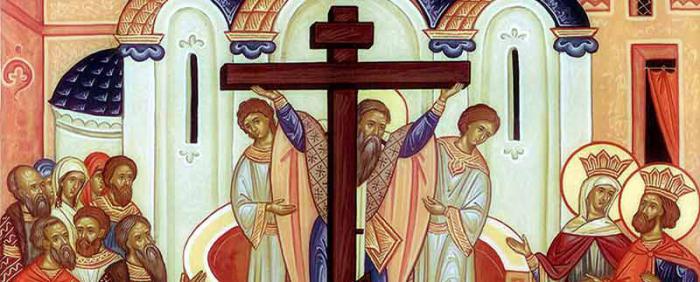
As soon as the priest is completely different, the great gloriousness begins. The rector performs certain actions with a cross, reads the tropari by the revolution of the Cross of the Lord. Next, the tropar is chasing three times with earth bows, then everything goes to poems with anointing with a bare. The worship service ends, freeing the place of liturgy.
Catholics holiday celebrate from the evening or in the morning (it all depends on the weekday or Sunday day fall on September 14). Evening worship begins with the Latin rite, and the morning consists of three knockturins, dedicated to the history of the return of the Cross of the Lord, the preaching of Pope. The sequence of stages is spelled out in a missal (liturgical book). So no change will happen, and the sermon to the upstream of the Cross of the Lord is similar to the texts of the passionate week.
Exaltation icons
Since the holiday is celebrated by Catholics and Orthodox differently, the icons have different stories. From the fifteenth century, the icon paints depict a lot of people at the temple, the center is occupied by Deacons with the Patriarch, who erects the cross decorated with plants, and from the opposite side the emperor Konstantin with Mother Elena is depicted.
Up to this period, the icon has undergone different changes and acquired a different look:
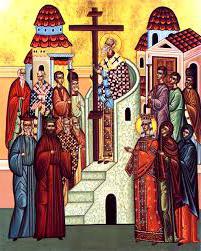
The main difference between the Catholic Icons from Orthodox - this is an image historical fact Returning the cross. Orthodox depict Elena with Konstantin, and Catholics - Emperor Heraclia. Thus, it seems to be different from Christians an icon of the erection of the Cross of the Lord, the importance of all the same - faith in God, the adoption of the fact of the resurrection of the Son of God, reverence of the cross as the salvation of the entire human race. This church holiday is dedicated not to crying the suffering of Christ, but joy after suffering tests. The cross is considered as an atonement instrument, elevated by him, Christians glorify the name of Christ.
History of the occurrence of crucifixion
Over time, the life-giving tree was pulled by pieces in different churches, now Christians only figuratively glorify the name of the Lord. At the same time, the Gospel does not mention the origin of the cross in contrast to the apocryphal legends. According to Bogomilskaya legend, the tree of good and evil from the Paradise Garden formed three trunks, meaning Adam, gentlemen and Eve. After the expulsion of people from Paradise, there was only the trunk of God, and the other parts of the tree fell to the ground. It is from them a crucifixion will be made for Christ (meaning the elimination of the Cross of the Lord). Photos of apocrypha can be found in museums and chronicles (Pierrot's most popular works).
According to the "golden" legend, after the death of Adam, a dry branch of the tree of good and evil, which his son brought from Archangel Michael to extend the Days of the Father was sprouting. The tree grew before the appearance of King Solomon, who quit it for the construction of the temple. However, the bridge was built from the bar, according to which the Queen of Sava refused to go, opening the importance of this tree. Solomon buried this timber, but after some time it was found. The tree washed the water that had medical propertiesTherefore, the Siloam Font was founded here. After the capture of Jesus, the timber pops up to the surface, and the Jews used it for the base of the crucifixion. Transverse boards were taken from trees of other breeds.
Church of Exaltation
The first church, built in honor of the life-giving Tree, was erected in the Palestinian Earth in the fourth century, under the Empress Elena. Then, with time, Antiochian, Constantinople, Alexandria, Roman Church arose. Immediately there are writers of canons and a poem. The most famous are Cosma Creators, Feofan who wanted to connect the plots of new and Old Testament. So, the pre-edges of the Patriarch Jacob, Moses, the Virgin and are associated with Jesus, a life-giving tree. Over time, prayers, troparps, Kondak, canons and akathist, were compiled, canons and akathist. 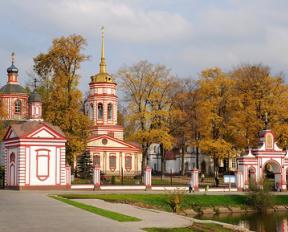
To date, a thousand monasteries have been created, cathedrals in honor of the life-giving Tree throughout Russia (Moscow, Nizhny Novgorod, Yekaterinburg, Perm region, Sverdlovsk region, Kaliningrad, Krasnoyarsk, Omsk, Petrozavodsk, Tutaevo, St. Petersburg, Republic of Komi, Kizlyar, Sevsk, Tver, Belgorod, Voronezh, Izhevsk, Irkutsk, Karelia, Kalmykia, Ufa, Kaluga).
On the territory of other countries, Christians also rebuilt religious objects in honor of the Exaltation. In Ukraine, these churches are located in Dnepropetrovsk, Donetsk, Lugansk, Kharkiv region, Poltava, Kamenets-Podolsk, Uzhgorod. In Moldova, under the Tiraspole, the Kitzansky Novo-Nyametsky is located male monastery with numerous buildings. There is also a museum library with rare books and shrines describing the exposure to the Cross of the Lord (Icon, Prayer, Song and other Christian attributes of the religious holiday are described in church publications).
As you can see, all over the world you can find monasteries, churches, cathedrals, temples, built in honor of the life-giving Tree. Many of them are preserved christian shrines, Religious services are held. Others are used as cultural tourist objects. Let us dwell in more detail at Moscow churches.
Non-obvious Moscow temples of the Exaltation
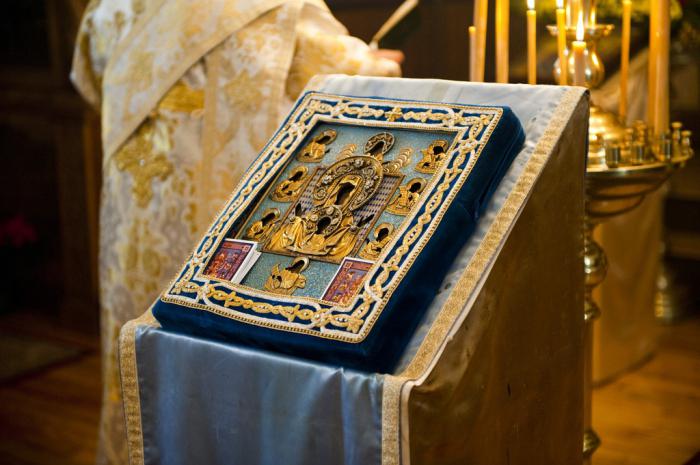
The current Moscow temples of the Exaltation
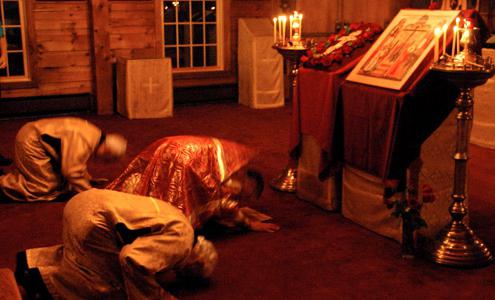
Demolished Moscow Evrification Churches
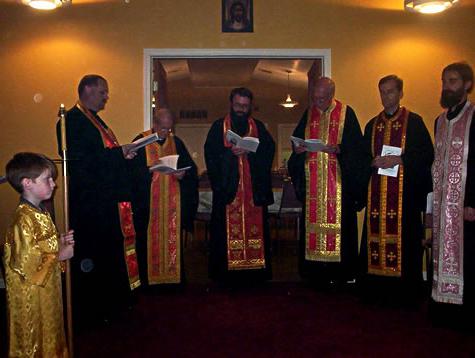
The elimination of the Cross of the Lord is an important holiday from Christians. The triumph of Catholics and Orthodox has differences, but the meaning of them is one. It is important to keep faith and love for God, glorify his name for the suffering suffering.